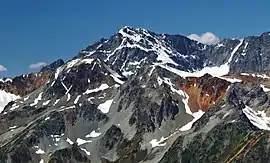Mount Sampson
Mount Sampson is a 2,811-metre (9,222-foot) mountain summit located in the Thiassi Range of the Coast Mountains, in the Pemberton Valley of southwestern British Columbia, Canada. It is the highest point in the Thiassi Range.[3] Sampson is situated 41 km (25 mi) northwest of Pemberton, and 21.5 km (13 mi) southeast of Mount Ethelweard, which is its nearest higher peak. Precipitation runoff from the peak drains into tributaries of the Lillooet and Hurley Rivers.
| Mount Sampson | |
|---|---|
 Mount Sampson, east aspect | |
| Highest point | |
| Elevation | 2,811 m (9,222 ft) [1] |
| Prominence | 1,261 m (4,137 ft) [1] |
| Parent peak | Mount Ethelweard (2819 m)[1] |
| Coordinates | 50°37′15″N 123°08′15″W [2] |
| Geography | |
 Mount Sampson Location in British Columbia  Mount Sampson Mount Sampson (Canada) | |
| Location | British Columbia, Canada |
| Parent range | Thiassi Range Coast Mountains |
| Topo map | NTS 92J/11 |
| Climbing | |
| First ascent | 1935 by J. Ronayne, R. Ronayne, P. Tait[1] |
| Easiest route | Scrambling class 3 from south [1] |
The mountain was named in association with Sampson Creek, which flows south from the mountain. In 1911, E.N. Sampson acquired a preemption located on the east side of the locally named Sampson Creek.[4] It was spelled Samson Mountain when it was first adopted in 1967 on maps. The spelling was officially corrected and adopted April 29, 1983, by the Geographical Names Board of Canada to conform with the creek.[2] The first ascent of the mountain was made in 1935 by Preston Tait, John Ronayne, and Ronald Ronayne.[1]
Climate
Based on the Köppen climate classification, Mount Sampson is located in a subarctic climate zone of western North America.[5] Most weather fronts originate in the Pacific Ocean, and travel east toward the Coast Mountains where they are forced upward by the range (Orographic lift), causing them to drop their moisture in the form of rain or snowfall. As a result, the Coast Mountains experience high precipitation, especially during the winter months in the form of snowfall. Temperatures can drop below −20 °C with wind chill factors below −30 °C. The mountain and its climate supports an unnamed glacier on its northern slope. The months July through September offer the most favorable weather for climbing Sampson.
References
- "Mount Sampson". Bivouac.com. Retrieved 2019-11-30.
- "Mount Sampson". Geographical Names Data Base. Natural Resources Canada. Retrieved 2019-11-30.
- "Mount Sampson, British Columbia". Peakbagger.com. Retrieved 2019-11-26.
- "Mount Sampson". BC Geographical Names.
- Peel, M. C.; Finlayson, B. L.; McMahon, T. A. (2007). "Updated world map of the Köppen−Geiger climate classification". Hydrol. Earth Syst. Sci. 11. ISSN 1027-5606.
See also

External links
- Weather: Mount Sampson
- Mt. Sampson photo: Flickr